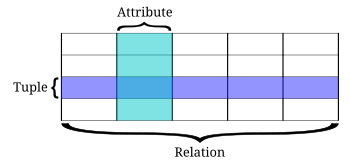For example, a data set containing all the real-estate transactions in a town can be grouped by the year the transaction occurred; or it can be grouped by the sale price of the transaction; or it can be grouped by the buyer's last name; and so on.
Such a grouping uses the relational model (a technical term for this is schema). Hence, such a database is called a "relational database."
The software used to do this grouping is called a relational database management system. The term "relational database" often refers to this type of software.
Relational databases are currently the predominant choice in storing financial records, manufacturing and logistical information, personnel data and much more.
Contents
Strictly, a relational database is a collection of relations (frequently called tables). Other items are frequently considered part of the database, as they help to organize and structure the data, in addition to forcing the database to conform to a set of requirements.
Terminology
The term relational database was originally defined and coined by Edgar Codd at IBM Almaden Research Center in 1970.[1]Relational database theory uses a set of mathematical terms, which are roughly equivalent to SQL database terminology. The table below summarizes some of the most important relational database terms and their SQL database equivalents.
| Relational term | SQL equivalent |
|---|---|
| relation, base relvar | table |
| derived relvar | view, query result, result set |
| tuple | row |
| attribute | column |
Relations or Tables
A relation is defined as a set of tuples that have the same attributes. A tuple usually represents an object and information about that object. Objects are typically physical objects or concepts. A relation is usually described as a table, which is organized into rows and columns All the data referenced by an attribute are in the same domain and conform to the same constraints.The relational model specifies that the tuples of a relation have no specific order and that the tuples, in turn, impose no order on the attributes. Applications access data by specifying queries, which use operations such as select to identify tuples, project to identify attributes, and join to combine relations. Relations can be modified using the insert, delete, and update operators. New tuples can supply explicit values or be derived from a query. Similarly, queries identify tuples for updating or deleting. It is necessary for each tuple of a relation to be uniquely identifiable by some combination (one or more) of its attribute values. This combination is referred to as the primary key.
from : wikipedia

0 comments:
Post a Comment